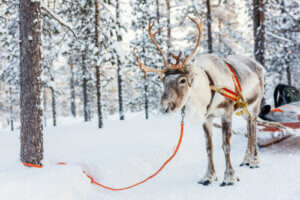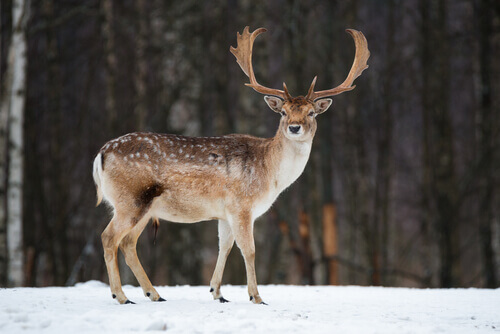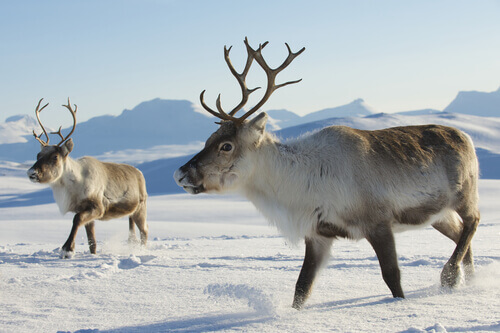The Differences Between Deer and Reindeer


Written and verified by the lawyer Francisco María García
Deer and reindeer belong to the same family of mammals known as Cervidae. These subfamilies have some important distinguishing characteristics despite their kinship and close resemblance.
Note that these animals belong to the same species. Also, the only different thing is the name, as both refer to the same animal.
In this respect, the term “deer” refers to an entire family while the reindeer are a subfamily. Note that there are more than 50 species of ruminant mammals in these subfamilies.
Deer and reindeer have similar characteristics. For one, their legs are usually long and slender, their necks long and their hair short. Moreover, all these ruminants digest food in the same way, regardless of the subfamily they belong to.
Their digestion is by rumination and consists of two parts: the first part consists of eating the food and the second of regurgitating it.
Specific differences between a deer and a reindeer
Deer
There are 27 species of deer in the world. However, the best known is Cervus canadensis. The main differences among them are the size of the antlers, the color of the coat, and the size.

On the whole, females are almost always smaller than males. Another relevant characteristic is that males have large antlers that begin to develop from the first year of age.
As time goes by, the antlers increase in size, complexity, and shape. Additionally, bucks also have hair all around the area around the neck and back.
Common deer have an ideal physiognomy for grazing. This activity is key to their diet since these ruminant mammals are herbivores.
As for where they come from, deer inhabit many areas around the world such as North Africa, Europe, America, Asia, and even the arctic zone.
Reindeer
This animal is also known as caribou and is a subspecies of the Capreolinae family. They inhabit the northern hemisphere and are native to the tundra and taiga zone.

Currently, their habitat is the global arctic, including Greenland. This association of reindeer to the cold areas of the planet is what made them part of Santa Claus’ sleigh fairy tale.
Hunting reindeer is legal. Moreover, some say doing so is necessary to maintain the balance in these cold ecosystems.
The male is larger than the female, like other subspecies. In fact, the female can weigh between 130 and 375 kilos. Males are considerably larger and can weigh over 600 pounds.
One of the most striking differences between reindeer and other species of this family is that both sexes have antlers. These are usually larger in males and grow more branches. Bony membranes may also develop between the branches.
Vision is another important part. The Arctic reindeer has ultraviolet vision that goes beyond the visible spectrum. Researchers explain that this trait is particularly helpful for distinguishing food and predators in the white Arctic winter.
Deer and reindeer have many differences and are quite similar at the same time. As we said at the beginning, there are over 50 subspecies of them and each has distinguishing characteristics that make them unique and special.
Deer and reindeer belong to the same family of mammals known as Cervidae. These subfamilies have some important distinguishing characteristics despite their kinship and close resemblance.
Note that these animals belong to the same species. Also, the only different thing is the name, as both refer to the same animal.
In this respect, the term “deer” refers to an entire family while the reindeer are a subfamily. Note that there are more than 50 species of ruminant mammals in these subfamilies.
Deer and reindeer have similar characteristics. For one, their legs are usually long and slender, their necks long and their hair short. Moreover, all these ruminants digest food in the same way, regardless of the subfamily they belong to.
Their digestion is by rumination and consists of two parts: the first part consists of eating the food and the second of regurgitating it.
Specific differences between a deer and a reindeer
Deer
There are 27 species of deer in the world. However, the best known is Cervus canadensis. The main differences among them are the size of the antlers, the color of the coat, and the size.

On the whole, females are almost always smaller than males. Another relevant characteristic is that males have large antlers that begin to develop from the first year of age.
As time goes by, the antlers increase in size, complexity, and shape. Additionally, bucks also have hair all around the area around the neck and back.
Common deer have an ideal physiognomy for grazing. This activity is key to their diet since these ruminant mammals are herbivores.
As for where they come from, deer inhabit many areas around the world such as North Africa, Europe, America, Asia, and even the arctic zone.
Reindeer
This animal is also known as caribou and is a subspecies of the Capreolinae family. They inhabit the northern hemisphere and are native to the tundra and taiga zone.

Currently, their habitat is the global arctic, including Greenland. This association of reindeer to the cold areas of the planet is what made them part of Santa Claus’ sleigh fairy tale.
Hunting reindeer is legal. Moreover, some say doing so is necessary to maintain the balance in these cold ecosystems.
The male is larger than the female, like other subspecies. In fact, the female can weigh between 130 and 375 kilos. Males are considerably larger and can weigh over 600 pounds.
One of the most striking differences between reindeer and other species of this family is that both sexes have antlers. These are usually larger in males and grow more branches. Bony membranes may also develop between the branches.
Vision is another important part. The Arctic reindeer has ultraviolet vision that goes beyond the visible spectrum. Researchers explain that this trait is particularly helpful for distinguishing food and predators in the white Arctic winter.
Deer and reindeer have many differences and are quite similar at the same time. As we said at the beginning, there are over 50 subspecies of them and each has distinguishing characteristics that make them unique and special.
All cited sources were thoroughly reviewed by our team to ensure their quality, reliability, currency, and validity. The bibliography of this article was considered reliable and of academic or scientific accuracy.
- Don E. Wilson & DeeAnn M. Reeder (editors). 2005. Mammal Species of the World. A Taxonomic and Geographic Reference (3rd ed), Johns Hopkins University Press, 2,142 pp. (Available from Johns Hopkins University Press, 1-800-537-5487 or (410) 516-6900, or at http://www.press.jhu.edu).
- Tyler, N. J. C., Jeffery, G., Hogg, C. R., Stokkan, K. A., & Giguère, N. (2014). Ultraviolet vision may enhance the ability of reindeer to discriminate plants in snow. Arctic, 159-166.
- Relva, M. A., & Sanguinetti, J. (2016). Ecología, impacto y manejo del ciervo colorado (Cervus elaphus) en el noroeste de la Patagonia, Argentina. Mastozoología neotropical, 23(2), 221-238.
- Abrantes, R. (2017). How wolves change rivers. Ethology Institute. Recuperado el 12 de abril de 2022, disponible en: https://ethology.eu/how-wolves-change-rivers/
This text is provided for informational purposes only and does not replace consultation with a professional. If in doubt, consult your specialist.








